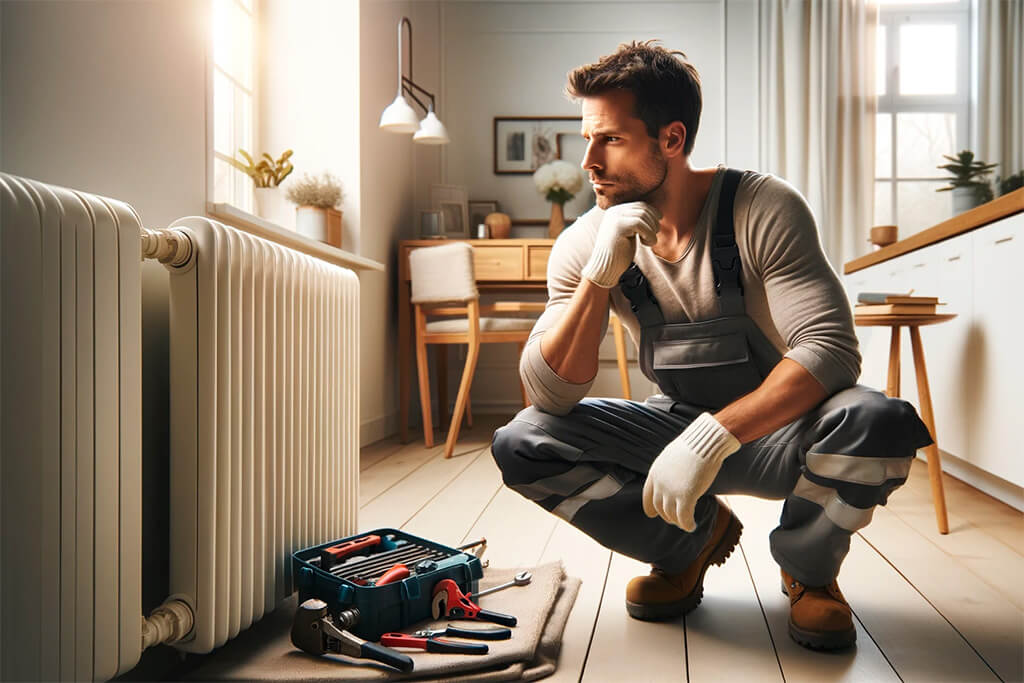Understanding the necessity of bleeding a radiator is foundational to maintaining an efficient heating system in your home. Air trapped within your radiator can impede hot water circulation, leading to rooms that are less cozy and more chilly. The primary indicators that suggest your radiator needs bleeding are unmistakable: cold spots despite a fully operational system, gurgling noises as if there’s a mini waterfall inside, and a general lack of warmth emanating from the unit. These symptoms indicate that air, an unwelcome guest in your heating system, is preventing the smooth flow of hot water and, consequently, efficient heating.

Tools and Preparation
Embarking on the task of bleeding a radiator requires a modest set of tools, a testament to the simplicity of the process yet a reminder of its importance. Your toolkit should include:
- A radiator key, a crucial element for unlocking the air from its metallic confines.
- A cloth or rag to catch any water that may escape during the process, protecting your floors and furnishings from potential stains.
- A bucket or bowl for the collection of water, should the amount exceed a mere dribble.
- Gloves, emphasizing the need for personal safety and comfort during the procedure.
Preparation extends beyond gathering tools, it involves setting the stage for a clean and efficient operation. Spread old towels or sheets around your workspace to guard against the inevitable drips or spills, reminiscent of rust-tinted water’s propensity to stain.
Step-by-Step Guide to Bleeding a Radiator
1. Identifying the Need for Bleeding
Routine observation of your radiators can reveal the need for bleeding. Cold spots, especially at the top of the radiator, are a clear indication that air is displacing water, hindering efficient heat distribution. This is akin to diagnosing a patient with symptoms before prescribing a remedy, the presence of these signs warrants immediate action.
2. Turning Off Your Heating System
Prior to engaging with the radiator, the heating system must be switched off. This precautionary measure is akin to turning off your vehicle before inspecting the engine, ensuring both safety and the prevention of hot water surprises. It also prevents the introduction of additional air into the system during the bleeding process, ensuring a smooth and controlled operation.
3. Locating the Bleed Valve
The bleed valve, typically situated at the top of the radiator, awaits your intervention with a radiator key or, in some cases, a simple flathead screwdriver. This small but pivotal component is the gateway to releasing trapped air and restoring your heating system’s efficiency. In the absence of a traditional radiator key, manufacturers often provide alternative tools or designs compatible with common household tools, ensuring that this crucial maintenance task remains accessible to all.

4. Bleeding the Radiator
Embarking on the radiator bleed, it’s crucial to arm yourself with the right tools—a radiator key or a trusty flathead screwdriver, depending on what your radiator demands. Here’s a seasoned approach to releasing trapped air without turning your floor into a makeshift pond:
- Prepare Your Work Area: A cloth or rag is indispensable for catching those initial drips, ensuring your floors remain spotless. If you anticipate more than a trickle, a bucket should be at the ready.
- Engage the Valve Gently: With your radiator key or screwdriver in hand, gently turn the valve counterclockwise. The hiss of escaping air is your cue that you’re on the right track. This sound signifies the release of pent-up air, a simple yet profound step towards efficiency.
- Seal the Deal: Once water makes its appearance, signaling the exodus of air, it’s time to close the valve. A gentle but firm turn clockwise should suffice—over-tightening is a common folly.
Completion Indicator: The cessation of hissing, accompanied by a steady dribble of water, heralds the successful bleeding of your radiator. The warmth should now flow unimpeded, a testament to a job well done.
5. Checking and Adjusting Boiler Pressure
Post-bleeding, a glance at your boiler’s pressure gauge is non-negotiable. It’s akin to checking the vitals after surgery—essential for ensuring the patient’s, or in this case, your heating system’s health:
- Gauge Inspection: Locate the pressure gauge and assess. A needle in the green zone is akin to a green light, anything else warrants further action.
- Pressure Boost: If the gauge reads low, introducing water via the filling loop is your next move. This act of balancing is delicate, too much pressure is as problematic as too little.
6. Restarting Your Heating System
With the bleeding complete and the pressure adjusted, it’s time to awaken your heating system from its slumber. Flip the switch to resurrect the system, but keep a watchful eye on the radiators and the boiler gauge. Should discrepancies arise, professional insight might be required.
Tips for Effective Radiator Maintenance
In the realm of heating maintenance, prevention is your strongest ally:
- Annual Check-Ups: A yearly bleeding can prevent the bulk of heating hiccups, keeping your system running smoothly.
- Achieving Balance: Uneven heating can often be rectified by balancing your radiators, ensuring an equitable distribution of warmth.
FAQ Section
Aim for an annual inspection, or whenever symptoms like cold spots or gurgling noises emerge.
While a radiator key is ideal, many systems accommodate alternatives like a flathead screwdriver. Adaptability is key in maintenance.
Persistent cold spots may hint at a need for balancing or a deeper issue. If in doubt, consult a professional.
Absolutely. This precaution prevents injury and ensures a thorough bleed.
Your boiler’s pressure gauge will guide you. After bleeding, a reading outside the recommended range indicates a need for adjustment.
